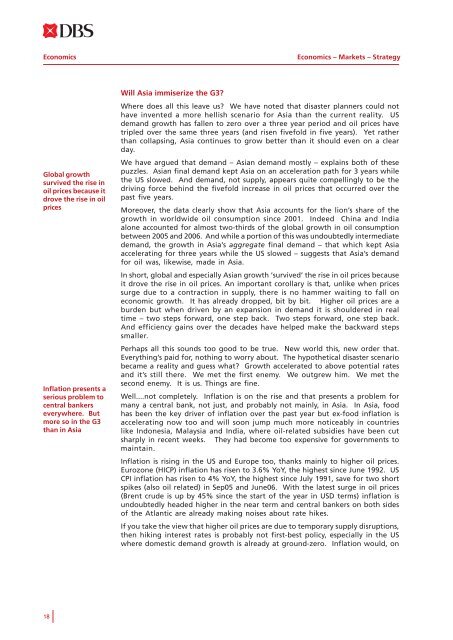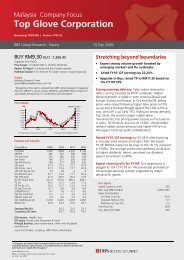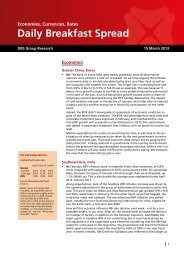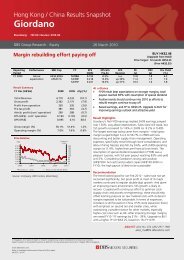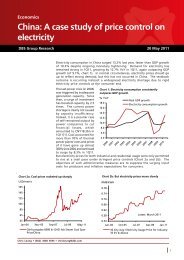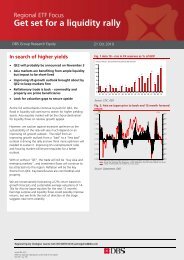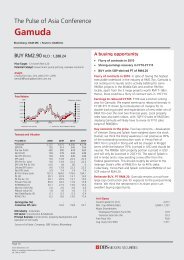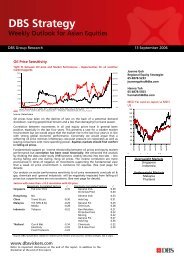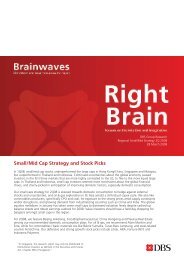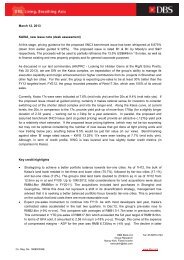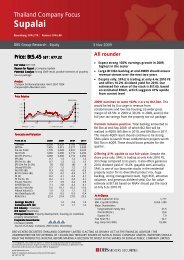Economics Markets Strategy - the DBS Vickers Securities Equities ...
Economics Markets Strategy - the DBS Vickers Securities Equities ...
Economics Markets Strategy - the DBS Vickers Securities Equities ...
You also want an ePaper? Increase the reach of your titles
YUMPU automatically turns print PDFs into web optimized ePapers that Google loves.
<strong>Economics</strong><br />
<strong>Economics</strong> – <strong>Markets</strong> – <strong>Strategy</strong><br />
Global growth<br />
survived <strong>the</strong> rise in<br />
oil prices because it<br />
drove <strong>the</strong> rise in oil<br />
prices<br />
Inflation presents a<br />
serious problem to<br />
central bankers<br />
everywhere. But<br />
more so in <strong>the</strong> G3<br />
than in Asia<br />
Will Asia immiserize <strong>the</strong> G3?<br />
Where does all this leave us? We have noted that disaster planners could not<br />
have invented a more hellish scenario for Asia than <strong>the</strong> current reality. US<br />
demand growth has fallen to zero over a three year period and oil prices have<br />
tripled over <strong>the</strong> same three years (and risen fivefold in five years). Yet ra<strong>the</strong>r<br />
than collapsing, Asia continues to grow better than it should even on a clear<br />
day.<br />
We have argued that demand – Asian demand mostly – explains both of <strong>the</strong>se<br />
puzzles. Asian final demand kept Asia on an acceleration path for 3 years while<br />
<strong>the</strong> US slowed. And demand, not supply, appears quite compellingly to be <strong>the</strong><br />
driving force behind <strong>the</strong> fivefold increase in oil prices that occurred over <strong>the</strong><br />
past five years.<br />
Moreover, <strong>the</strong> data clearly show that Asia accounts for <strong>the</strong> lion’s share of <strong>the</strong><br />
growth in worldwide oil consumption since 2001. Indeed China and India<br />
alone accounted for almost two-thirds of <strong>the</strong> global growth in oil consumption<br />
between 2005 and 2006. And while a portion of this was undoubtedly intermediate<br />
demand, <strong>the</strong> growth in Asia’s aggregate final demand – that which kept Asia<br />
accelerating for three years while <strong>the</strong> US slowed – suggests that Asia’s demand<br />
for oil was, likewise, made in Asia.<br />
In short, global and especially Asian growth ‘survived’ <strong>the</strong> rise in oil prices because<br />
it drove <strong>the</strong> rise in oil prices. An important corollary is that, unlike when prices<br />
surge due to a contraction in supply, <strong>the</strong>re is no hammer waiting to fall on<br />
economic growth. It has already dropped, bit by bit. Higher oil prices are a<br />
burden but when driven by an expansion in demand it is shouldered in real<br />
time – two steps forward, one step back. Two steps forward, one step back.<br />
And efficiency gains over <strong>the</strong> decades have helped make <strong>the</strong> backward steps<br />
smaller.<br />
Perhaps all this sounds too good to be true. New world this, new order that.<br />
Everything’s paid for, nothing to worry about. The hypo<strong>the</strong>tical disaster scenario<br />
became a reality and guess what? Growth accelerated to above potential rates<br />
and it’s still <strong>the</strong>re. We met <strong>the</strong> first enemy. We outgrew him. We met <strong>the</strong><br />
second enemy. It is us. Things are fine.<br />
Well....not completely. Inflation is on <strong>the</strong> rise and that presents a problem for<br />
many a central bank, not just, and probably not mainly, in Asia. In Asia, food<br />
has been <strong>the</strong> key driver of inflation over <strong>the</strong> past year but ex-food inflation is<br />
accelerating now too and will soon jump much more noticeably in countries<br />
like Indonesia, Malaysia and India, where oil-related subsidies have been cut<br />
sharply in recent weeks. They had become too expensive for governments to<br />
maintain.<br />
Inflation is rising in <strong>the</strong> US and Europe too, thanks mainly to higher oil prices.<br />
Eurozone (HICP) inflation has risen to 3.6% YoY, <strong>the</strong> highest since June 1992. US<br />
CPI inflation has risen to 4% YoY, <strong>the</strong> highest since July 1991, save for two short<br />
spikes (also oil related) in Sep05 and June06. With <strong>the</strong> latest surge in oil prices<br />
(Brent crude is up by 45% since <strong>the</strong> start of <strong>the</strong> year in USD terms) inflation is<br />
undoubtedly headed higher in <strong>the</strong> near term and central bankers on both sides<br />
of <strong>the</strong> Atlantic are already making noises about rate hikes.<br />
If you take <strong>the</strong> view that higher oil prices are due to temporary supply disruptions,<br />
<strong>the</strong>n hiking interest rates is probably not first-best policy, especially in <strong>the</strong> US<br />
where domestic demand growth is already at ground-zero. Inflation would, on<br />
18


